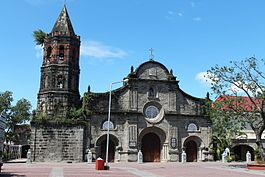Central Luzon Region
|
Central Luzon Region III |
|||||
|---|---|---|---|---|---|
| Region | |||||
|
|||||
| Nickname(s): Rice Granary of the Philippines | |||||
 Location in the Philippines |
|||||
| Coordinates: 15°28′N 120°45′E / 15.47°N 120.75°ECoordinates: 15°28′N 120°45′E / 15.47°N 120.75°E | |||||
| Country | Philippines | ||||
| Island group | Luzon | ||||
| Regional center | San Fernando (Pampanga) | ||||
| Area | |||||
| • Total | 22,014.63 km2 (8,499.90 sq mi) | ||||
| Population (2015 census) | |||||
| • Total | 11,218,177 | ||||
| • Density | 510/km2 (1,300/sq mi) | ||||
| Time zone | PST (UTC+8) | ||||
| ISO 3166 code | PH-03 | ||||
| Provinces | |||||
| Cities | |||||
| Municipalities | 116 | ||||
| Barangays | 3,102 | ||||
| Cong. districts | 20 | ||||
| Languages |
|
||||
Central Luzon (Kapampangan: Kalibudtarang Luzon; Pangasinan: Pegley na Luzon; Ilocano: Tengnga a Luzon; Tagalog: Gitnang Luzon), designated as Region III, is an administrative region in the Philippines, primarily serving to organize the 7 provinces of the vast central plains of the island of Luzon (the largest island), for administrative convenience. The region contains the largest plain in the country and produces most of the country's rice supply, earning itself the nickname "Rice Granary of the Philippines". Its provinces are: Aurora, Bataan, Bulacan, Nueva Ecija, Pampanga, Tarlac and Zambales.
Central Luzon Region is located north of Manila, the nation's capital. Bordering it are the regions of Ilocos and Cagayan Valley to the north; National Capital Region, CALABARZON and the waters of Manila Bay to the south; South China Sea to the west; and the Philippine Sea to the east.
There are fourteen cities in the region: Balanga in Bataan; Malolos, Meycauayan and San Jose del Monte in Bulacan; Cabanatuan, Gapan, Muñoz, Palayan and San Jose in Nueva Ecija; Angeles, Mabalacat and San Fernando in Pampanga; Tarlac in Tarlac; and Olongapo in Zambales. Central Luzon produces the most rice in the whole country. Excess rice is delivered and imported to other provinces of the Philippines.
...
Wikipedia



